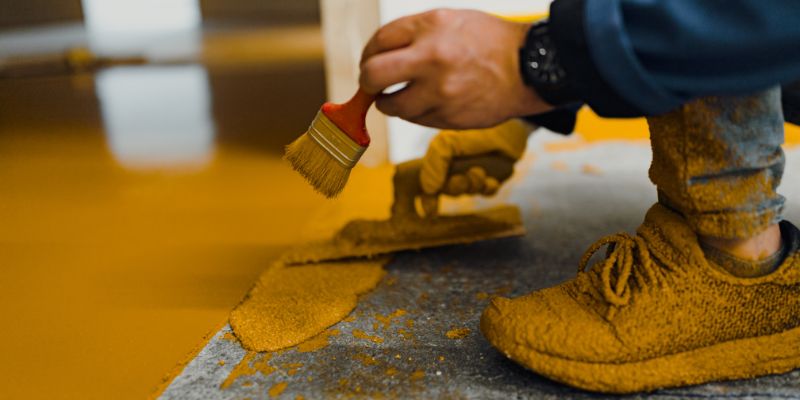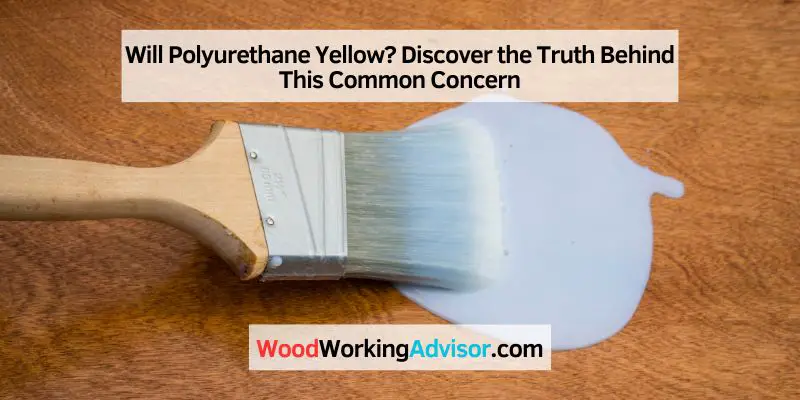Yes, polyurethane can yellow over time. Polyurethane can undergo a chemical reaction with sunlight or certain chemicals, causing it to change color and turn yellow.
This yellowing can affect the appearance of the polyurethane finish on surfaces such as wood or plastic. Polyurethane is a popular choice for protecting and enhancing the durability of various surfaces, but one common concern is its tendency to yellow.
Whether it’s applied to furniture, flooring, or other finished products, polyurethane can gradually develop a yellow tint. This change in color can be attributed to the chemical reaction between polyurethane and factors such as sunlight or specific chemicals. While this yellowing effect may not be desired or aesthetically pleasing, it is a common occurrence that users should be aware of when considering polyurethane for their projects. We will explore the reasons behind polyurethane yellowing and discuss some preventive measures to maintain the clarity and appearance of polyurethane finishes.
What Is Polyurethane?
Polyurethane is a durable material used in various products. Over time, it may turn yellow due to prolonged exposure to sunlight and heat. It’s essential to protect polyurethane items from these elements to maintain their original color and appearance.
Polyurethane is a versatile and highly durable synthetic material that is widely used in various industries. With its exceptional properties, it has become a popular choice for a wide range of applications. Polyurethane is known for its excellent resistance to wear, tear, and abrasion. It is also highly flexible and can be molded into different shapes and forms.
Composition Of Polyurethane
Polyurethane is composed of a combination of two main components: polyols and isocyanates. Polyols are organic compounds that contain multiple hydroxyl (OH) groups, while isocyanates are compounds that contain multiple isocyanate (NCO) groups. When these two components react with each other, a chemical reaction occurs known as polymerization, which forms the solid structure of polyurethane.
In addition to polyols and isocyanates, polyurethane can also contain other additives such as catalysts, blowing agents, and fillers. These additives help to enhance specific properties of polyurethane, such as its elasticity, hardness, and flame resistance.
Common Uses Of Polyurethane
Polyurethane has a wide range of applications due to its versatility and durability. Some common uses of polyurethane include:
- Furniture: Polyurethane foam is commonly used in the manufacturing of furniture, including sofas, chairs, and mattresses. Its high resilience and comfort make it an ideal choice for cushions and padding.
- Coatings: Polyurethane coatings provide excellent protection and resistance against chemicals, abrasion, and UV radiation. They are often used in the automotive industry, construction, and marine applications.
- Insulation: Polyurethane foam insulation is widely used in the construction industry for its excellent thermal insulation properties. It helps to reduce energy consumption and improve heating and cooling efficiency.
- Footwear: Polyurethane is frequently used in the production of footwear, providing cushioning, shock absorption, and durability. It is commonly found in athletic shoes, boots, and sandals.
- Automotive: Polyurethane is used in various automotive parts and components, including bumpers, dashboards, and seating. Its high strength and ability to withstand harsh conditions make it ideal for automotive applications.
Polyurethane’s adaptability and performance make it a valuable material across numerous industries. Its ability to withstand wear and tear, as well as its versatility in various forms, contribute to its widespread use in countless applications.

Understanding The Yellowing Process
Understanding the Yellowing Process:
Polyurethane is a commonly used coating for various surfaces due to its durability and protective properties. However, over time, you may notice that polyurethane can develop a yellowish tint. To fully comprehend this yellowing process, it is important to understand the factors contributing to it, as well as the effects of the environment on polyurethane.
Factors Contributing To Yellowing:
- UV radiation exposure
- Aging of the polyurethane
- Presence of certain chemicals
Yellowing of polyurethane is primarily a result of exposure to UV radiation. The sun’s ultraviolet rays can accelerate the breakdown of the polyurethane’s structure, leading to the development of a yellow hue. Additionally, the aging process of the polyurethane over time can also contribute to its yellowing. As the coating ages, it becomes more vulnerable to environmental factors and can gradually change color. Moreover, certain chemicals present in the surrounding environment, such as formaldehyde or ammonia, can react with the polyurethane and cause it to yellow.
Effects Of Environment On Polyurethane:
The environment in which polyurethane is exposed can significantly impact its yellowing process. Factors such as temperature, humidity, and airflow can all influence the aging and yellowing of the coating. High temperatures can accelerate the breakdown of the polyurethane, while high humidity levels can introduce moisture that can affect its structure. Similarly, inadequate airflow can prevent the coating from properly drying, potentially leading to discoloration. It is important to consider these environmental factors when applying and maintaining polyurethane coatings to minimize yellowing and prolong its lifespan.
Debunking Common Myths
Debunking common myths about polyurethane yellowing is crucial for anyone considering using this type of finish for their projects. There are many misconceptions surrounding polyurethane yellowing that can lead to confusion and misinformed decisions. Let’s address these myths and provide clarity on this topic.
Clarifying Misconceptions About Polyurethane Yellowing
Myth 1: Polyurethane will always be yellow over time.
Fact: While some polyurethane products may yellow over time, advancements in technology have led to the development of non-yellowing formulas. Look for products labeled as “non-yellowing” or “water-based” to minimize the risk of yellowing.
Myth 2: All types of wood finishes are susceptible to yellowing.
Fact: Certain wood finishes, especially solvent-based ones, are more prone to yellowing compared to water-based alternatives. Choosing the right type of polyurethane for your project can significantly reduce the risk of yellowing.
Addressing Concerns
- Overexposure to sunlight can accelerate the yellowing process.
- Choosing water-based polyurethane can help prevent yellowing.
By understanding the factors that contribute to polyurethane yellowing and debunking the common myths associated with it, you can make informed decisions when selecting the right finish for your woodworking projects.

Credit: www.amazon.com
Preventing Yellowing Of Polyurethane
Polyurethane can yellow over time, but steps can be taken to prevent this discoloration. Properly storing it away from sunlight and using UV-resistant finishes can help maintain its original color and prevent yellowing.
Best Practices For Application
Polyurethane, a popular finish for wood surfaces, has the tendency to yellow over time due to exposure to sunlight and other environmental factors. However, by following a few best practices during application, you can minimize the chances of yellowing and ensure a long-lasting, clear finish.
- Clean and prepare the surface: Before applying polyurethane, it is important to clean and prepare the surface properly. Remove any dirt, grease, or previous finishes using a mild detergent and sandpaper. This will ensure proper adhesion and reduce the likelihood of yellowing.
- Use a high-quality product: Invest in a high-quality polyurethane product specifically designed for clarity and UV resistance. These formulations are less likely to yellow and offer better protection against discoloration.
- Apply thin coats: When applying polyurethane, it is crucial to avoid thick coats. Thick layers of polyurethane are more prone to yellowing, so it is best to apply multiple thin coats instead. This allows for better curing and minimizes the chances of yellowing.
Proper Maintenance
Even with the best application practices, polyurethane may still experience some yellowing over time. However, proper maintenance can help slow down the yellowing process and keep the finish looking clear and fresh.
- Keep out of direct sunlight: Excessive exposure to sunlight can accelerate the yellowing of polyurethane. To prevent this, consider using blinds, curtains, or UV-protective window films to block out direct sunlight.
- Avoid harsh chemicals: Certain cleaning agents and chemicals can cause discoloration of polyurethane. To maintain its clarity, use only mild, non-abrasive cleaners and avoid harsh chemicals or solvents.
- Regular cleaning and dusting: Routine cleaning and dusting help remove dirt and debris that can contribute to discoloration. Use a soft, lint-free cloth or mop to gently clean the surface without scratching the finish.
- Reapply a protective coat: Over time, the protective layer of polyurethane may wear off. To maintain its clarity and prevent yellowing, consider periodically reapplying a thin coat of polyurethane to the surface.
Conclusion And Recommendations
After delving into the topic of whether polyurethane is yellow over time, we can draw some conclusions and provide recommendations for preserving polyurethane finishes.
Summary Of Key Points
- Exposure to UV light and certain chemicals can cause polyurethane to yellow over time.
- Higher-quality polyurethane products tend to resist yellowing better than lower-quality ones.
- Choosing water-based polyurethane may help reduce the chances of yellowing.
- Yellowing can also be influenced by environmental factors such as temperature and humidity.
- Proper surface preparation and application techniques can help achieve a more durable and long-lasting finish.
Tips For Preserving Polyurethane Finishes
To ensure your polyurethane finishes maintain their clarity and color over time, consider the following recommendations:
- Limit exposure to direct sunlight by using blinds or curtains to protect furniture or surfaces.
- Avoid placing polyurethane-coated items near heat sources, such as radiators or heating vents.
- Regularly dust and clean polyurethane surfaces with a gentle, non-abrasive cleaner.
- Use furniture polish or wax specifically formulated for polyurethane surfaces to enhance their protection.
- Consider applying additional coats of polyurethane every few years to refresh the appearance and protection.
By following these tips and taking proper care of your polyurethane finishes, you can minimize the likelihood of yellowing and enjoy their beauty for years to come.

Frequently Asked Questions On Will Polyurethane Yellow
What Polyurethane Does Not Yellow?
Some types of polyurethane do not yellow over time. These polyurethanes have special additives that prevent discoloration, making them suitable for applications where maintaining a clear and non-yellow finish is important.
How Do You Finish Wood Without Yellowing?
To finish wood without yellowing, use a water-based polyurethane or a UV-resistant finish. Avoid oil-based finishes, which can yellow over time. Make sure to apply thin, even coats and allow for adequate drying time between layers. Regular maintenance and cleaning can also help preserve the wood’s natural color.
Will Oil-Based Polyurethane Yellow Over Time?
Yes, oil-based polyurethane can be yellowed over time.
Will Water-Based Polyurethane Yellow Over White Paint?
Water-based polyurethane may yellow over white paint due to its inherent properties. However, using a high-quality, non-yellowing water-based polyurethane, proper application, and regular maintenance can help minimize this effect. Consider conducting a test on a small area before applying to the entire surface.
Conclusion
The potential yellowing of polyurethane is a common concern among users. By understanding the contributing factors and implementing preventative measures, such as choosing the right type of polyurethane and proper application techniques, you can minimize the risk of yellowing and preserve the beauty of your surfaces.
Stay informed and proactive to maintain the longevity and appearance of your polyurethane-coated items.


